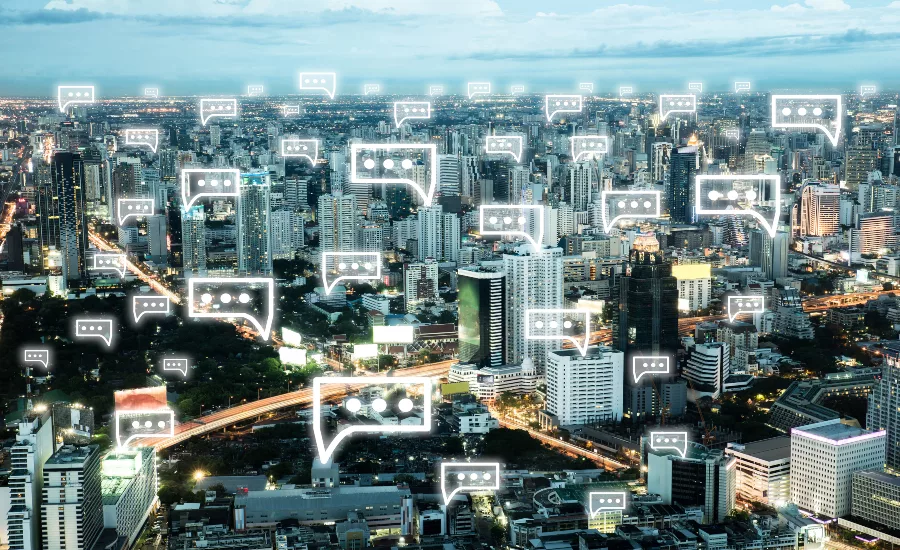How to optimize critical communications in the age of COVID-19 (and beyond)

<a href='https://www.freepik.com/photos/background'>Background photo created by jcomp - www.freepik.com</a>
The primary security operations topic in 2021 continues to be the global pandemic – and for good reason. One of the most obvious challenges to achieving herd immunity is vaccinating enough people to keep the virus from spreading.
As COVID-19 vaccines roll out throughout the country, many organizations and government entities are facing – or soon will be facing – challenges around the logistics, distribution of information and administration of those vaccines.
How do you communicate vaccine availability to specific groups of people? And how do you effectively communicate and facilitate the logistics for any single person receiving a vaccine?
The complexity of communicating throughout the process of vaccine distribution is increased by the sheer number of organizations involved in the vaccination process. From government at the federal, state and local levels to health departments, drug stores, retail chains and residents, successful mass immunization requires efficient, targeted communication and cooperation across a wide range of entities.
Enter: critical communications.
Though many of us in the security industry are well-versed in the value of emergency mass notification technology, we have entered what is arguably this sector’s most significant era, as it plays a central role in the largest public health initiative in modern times. Now more than ever, organizations need to take a closer look at their critical communications practices to ensure they foster operational resilience and efficiency.
Whether you are a municipality turning to an emergency mass notification solution to help you distribute vaccine doses, a company looking to safeguard an unprecedently remote and distributed workforce until it’s safe to return to the office, or any other organizational decision maker exploring technology to help solve countless pandemic-related critical event management challenges, here are some best practices to keep in mind in the months ahead:
Advance your risk intelligence capabilities.
In instances of a crisis or security risk, every minute counts. Having a system in place that can monitor critical events in real time and quickly identify relevant threats to vaccine availability and accessibility will enable you to make proactive decisions that protect your people, places and property.
To that end, forward-thinking leaders are leveraging artificial intelligence-driven risk intelligence capabilities to increase the speed and accuracy of how they are identifying and responding to emerging threats. AI and machine learning can ingest thousands of verified data sources, identify the most critical events facing an organization and deliver tailored alerts to the right people at the right time – far faster than human analysts.
Therefore, complementing your critical communications infrastructure with risk intelligence technology can provide early warning of adverse events, such as the inclement weather that has put further strain on local government teams responsible for advancing immunization while keeping roads open and electricity running.
Communicate before you execute.
It’s important to communicate with the right people before there is a need to reach them. To prepare, ensure you are continuously building your database of critical communications recipients. If you’re only truly starting this process as it’s time to press ‘send,’ you’re too late.
When it comes to vaccine deployment, successfully sharing the availability of injections and scheduling appointments to get injections in the arms of specific groups is vital to success, particularly when:
- You are communicating to different demographics with differing levels of technology usage.
- When it involves the careful cadence of two doses, which requires the support of critical communications technology on a massive scale.
Therefore, governments and public health authorities need to build a sophisticated database of residents they may need to engage, as well as multiple ways for those residents to sign-up for communication. This can be accomplished by proactively sharing sign-up information with the prospective message recipients via email, social media, press releases, including it on the website and mentioning the solution during public hearings and forums.
There is also an increased need now to manage these databases more closely and share sign-up information on an ongoing basis. Given the pandemic, people have made permanent and temporary moves from their original residences to avoid more populated cities and areas with greater COVID-19 risks. As people move away from or to different areas, having accurate information on who is where can help ensure that the right people receive the right messages at the right time.
Prepare for a dialogue.
In addition to having an accurate database of notification and alert recipients well in advance, organizations can achieve resiliency amid evolving COVID-19 challenges by proactively preparing communications messages in anticipation of common scenarios. Build templates for these likely situations with simple and clear messages that can be ready when needed.
Some of the specific messages you may consider preparing are those related to COVID-19 exposure. New laws in California are requiring companies to notify their employees and subcontractors if they have been exposed to COVID-19 at a worksite. Having concise communications ready that trigger engagement from the recipient can help protect the safety and well-being of your organization and its people.
For COVID-19 vaccination and infectious disease mitigation efforts in particular, messages should also encourage two-way communication between public health authorities and citizens, such as prompting residents to confirm their scheduled vaccine and come back for their second dose. This feedback loop will help maximize the choregraphed deployment for both rounds of vaccination. Organizations also need a system that encourages two-way dialogue to keep employees informed about the benefits of vaccination; collect feedback from employees on pre- and post- appointment check-ins, as well as potential side effect reports; and even engage with staff surrounding vaccine hesitancy.
Test, test, and then test again.
It is simply too late to test your critical communications systems when a critical event hits.
Teams should regularly test critical communications software to ensure it works as expected. Just as risk intelligence is used to foresee the unexpected, proactive testing can mitigate problems prior to your messages being sent.
A key part of testing includes encouraging recipient participation and confirmation they received your test alerts or notifications. Not only does proactive testing ensure your messages are reaching the right people and your infrastructure is in order, it also helps familiarize the recipients with you, so they don’t dismiss important alerts as spam or some unwanted communication. Fostering this trust between the sending party and receiving party is vital to the success of any critical communications framework, particularly in the context of public health imperatives.
Leverage integrated critical communication technology platforms.
As COVID-19 challenges continue to evolve, organizations need to be prepared to react quickly and communicate to a growing number of internal and external stakeholders in real time throughout these events.
There is a growing need for critical communications solutions that streamline this process. Software that integrates risk intelligence, critical communications and incident management in one platform and connects with your other business continuity solutions can help ensure your organization is safe, informed, and connected when it matters most.
From aggressive vaccination efforts across the U.S. to mitigating new COVID-19 outbreaks, leaders must equip their communications functions to anticipate, mitigate and resolve these threats more efficiently than ever before, as speed, relevance and usability within critical event management will directly save lives during this time.
In summary, not only is it important to optimize your messages and databases so that your communications are reaching and engaging the right audience, but it’s also imperative to have a central, trusted platform that can accomplish three pivotal objectives: 1) quickly identify threats to your business; 2) communicate information and instruction to mitigate the threat; and 3) build a two-way dialogue between your organization and message recipients to resolve risk.
Now is the time to optimize critical communications to maintain resiliency through new COVID-19 challenges and beyond.
This article originally ran in Security, a twice-monthly security-focused eNewsletter for security end users, brought to you by Security Magazine. Subscribe here.
Looking for a reprint of this article?
From high-res PDFs to custom plaques, order your copy today!







